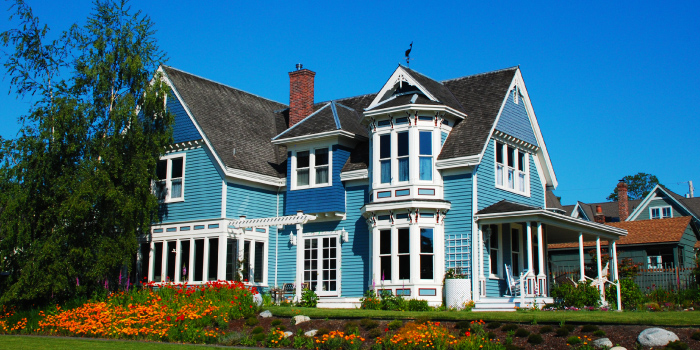Much like America itself, the American home has undergone several remarkable transformations throughout history. As the needs, lifestyles, and preferences of Americans changed, architectural trends did, too. This leaves a fascinating trail for us to follow as we explore the evolution of the styles, features, and designs of the American home, from colonial days to the 21st century.
Early Days: Colonial and Neoclassical (1600s-1860s)
Colonial
The story of the American home begins with the colonial period, where early settlers built modest, practical structures influenced by their European heritage.
Exteriors were balanced and well-proportioned, while interiors focused on central gathering spaces, including centrally-located fireplaces for efficient heating. These homes were built using local materials and were functional responses to the harsh climate and limited resources of the New World. They were also a reflection of American values at the time, including both independence and community.
Key characteristics:
- Simple
- Functional
- Designed for social gatherings
Neoclassical
Neoclassical homes, which gained momentum in the late 1700s and remained popular into the 1800s, retained the balance, symmetry, and harmony of the colonial style, while also adding a touch of elegance and sophistication.
These homes often included elements of Greek and Roman architecture, including columns, porticos (porches) with triangular pediments over them, friezes, and more. This reinterpretation of classical architecture reflects Americans’ renewed interest in classical values at the time, including a focus on knowledge and art. Some of America’s most famous buildings are built in a neoclassical style, including the White House and the U.S. Capitol.
Key characteristics:
- Columns
- Grand scale
- Symmetrical
- Square or rectangular floor plans
Expansion and Flourish: Victorian and Gilded Age (1870s-1930s)
Victorian
As America expanded westward, the diversity of architectural styles expanded as well. The Victorian era—and its cultural emphasis on wealth and sophistication—introduced ornate designs to the American home, characterized by intricate details, asymmetry, and refined decorative elements.
The Queen Anne style, with its turrets and vibrant colors, became an iconic representation of this period. The rise of the middle class fueled a demand for more elaborate and spacious homes, where people could express their individuality and add more artistry to their living spaces.
Key characteristics:
- Wraparound porches and bay windows
- Asymmetrical
- Ornamental (detailed, colorful, and “charming”)
Gilded Age
In the late 1800s and early 1900s, several American families had accumulated substantial generational wealth. Several of them used that wealth to build large family homes that reflected a variety of European styles, including Gothic, Baroque, and Renaissance.
While the actual style of each home may have been different, what they had in common was the grandeur. These homes were built to be impressive and opulent, and were often highly detailed and lavishly furnished.
Key characteristics:
- Large and extravagant
- Separate rooms for different purposes (entrance hall, library, ballroom, music room, etc.)
- Expensive materials, including marble, crystal, parquet wood, etc.
Return to Simplicity: Craftsman, Cape Cod, and Minimal Traditional (1900s-1940s)
Craftsman
In direct response to Victorian design, Craftsman homes were all about, well, craftsmanship. They celebrated the use of natural materials and placed a focus on comfort and functionality rather than showmanship. They used space efficiently and often included practical floor plans and low-pitched roofs, along with things like built in bookcases and cabinets.
Bungalows, one-story homes that usually include more open floor plans, are part of this movement.
Key characteristics:
- Natural materials (wood, stone, etc.)
- Handcrafted details and efficient built-in features
- Low-pitched roofs to better fit into surrounding nature
Cape Cod
Hearkening back to a more colonial style, Cape Cod homes focus on simplicity and comfort, relying on familiarity and practicality to appeal to families during times of economic upheaval.
This style of home was particularly common in New England, since the steep, slanted roof allowed snow to slide off easily.
Key characteristics:
- Simple, with little ornamentation
- Steep roofs with chimneys
- Modest in size and efficiently designed
Minimal Traditional
Taking simplicity to a new level, Minimal Traditional homes popped up everywhere near the mid-20th century. Usually single-story, small, and undetailed, these homes were a good, affordable option for young families or soldiers returning home from the war.
Key characteristics:
- Small square footage
- Simple, classic roofline with little-to-no overhang
- Asymmetrical design
The Rise of Suburbia: Ranch, Split Level, and McMansion (1950s-1990s)
Ranch
In the mid-1900s, post-war America was ready for a more relaxed and informal lifestyle. Additionally, as highways were built, Americans were able to expand their daily lives into the suburbs.
Ranch-style homes reflect this more casual vibe, with low rooflines; long, single-story floor plans; and windows to let in natural light. As a reflection of a “commuter” lifestyle, these homes also often included attached garages.
Key characteristics:
- Long, low profile
- More modern look
- Flow between indoors and outdoors
Split Level
A variation on the ranch style, split level homes maintained a streamlined, mid-century aesthetic while offering a bit more versatility and space. These homes typically have common areas on a main level, with a small staircase leading either up or down to bedrooms and family spaces.
This layout also made it possible for these homes to be built on hills and other areas that were previously difficult to develop.
Key characteristics:
- Multi-level design
- Overall sleek and low profile, with clean, horizontal lines
McMansion
As prosperity spread to suburban areas, wealthier families took the opportunity to build large, ostentatious homes that came to be known as “McMansions.” Built to impress, McMansions typically combine several architectural styles into one home, ultimately creating an incohesive look that fell out of favor in the late 2000s.
More than anything, McMansions are characterized by their size, odd proportions, showy exterior details, and awkward layouts.
Key characteristics:
- Large size, with ill-proportioned features (small windows, large doors, odd placement, etc.)
- Focus on curb appeal
- Sprawling floor plans with an awkward layout
Design for the Modern World: Neo-Eclectic, Transitional (2000s-2020s)
Neo-Eclectic
As America progressed into the 21st century, the American home began to reflect an architectural style that attempted to combine the best of all worlds. Like McMansions, Neo-Eclectic homes combine many different styles into one home; however, the 21st-century version of this method pays more attention to proportions and layout.
These homes typically feature varied roof lines, large windows, and an asymmetrical facade. Details like shutters, arched doorways, and decorative brackets are also common. This era popularized open floor plans—a floor plan in which the main community spaces are all open to each other—while still offering the option for various rooms.
Key characteristics:
- Mix of architectural styles (individualized design)
- Open floor plans
- Decorative details
Transitional
In the 2010s and 2020s, the transitional style has jumped in popularity. This style blends traditional and contemporary elements to create a home that feels timeless, balanced, and widely appealing.
Transitional architecture is known for clean lines, a focus on multifunctionality, and open floor plans. It’s also very common for these homes to include classic details like crown molding, wainscoting, and coffered ceilings.
Key characteristics:
- Blends classic and modern elements
- Clean lines and relatively simple, balanced designs
- Uses a variety of materials including brick, wood, glass, metal, and stone
As the American home has evolved from its humble beginnings, each era has left its mark on the architectural landscape. From simple cottages to grand estates, America has told an architectural story that is as diverse and as ever-changing as its cultural one. The only question now is: where will it go next?
Looking for help managing your HOA community? Contact Spectrum Association Management today to get your free quote and to learn why we’re one of the top rated HOA management companies in Texas and Arizona.







